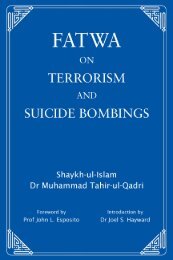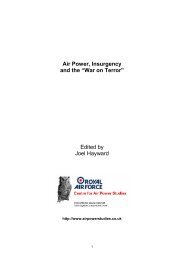Air Power, Insurgency and the âWar on Terrorâ - Prof. Joel Hayward's ...
Air Power, Insurgency and the âWar on Terrorâ - Prof. Joel Hayward's ...
Air Power, Insurgency and the âWar on Terrorâ - Prof. Joel Hayward's ...
Create successful ePaper yourself
Turn your PDF publications into a flip-book with our unique Google optimized e-Paper software.
The RAF in Counter-<str<strong>on</strong>g>Insurgency</str<strong>on</strong>g> Warfare: British Interventi<strong>on</strong> in Greece, 1944-45<br />
assistance up to this point, <str<strong>on</strong>g>the</str<strong>on</strong>g> <str<strong>on</strong>g>Air</str<strong>on</strong>g> Force Liais<strong>on</strong> Officers were increasingly at <str<strong>on</strong>g>the</str<strong>on</strong>g> forefr<strong>on</strong>t<br />
of discussi<strong>on</strong>s over <str<strong>on</strong>g>the</str<strong>on</strong>g> “art of <str<strong>on</strong>g>the</str<strong>on</strong>g> possible,” given <str<strong>on</strong>g>the</str<strong>on</strong>g> air support <strong>on</strong> offer. In fact, <str<strong>on</strong>g>the</str<strong>on</strong>g> best<br />
work <strong>on</strong> effect was performed by <str<strong>on</strong>g>the</str<strong>on</strong>g> RAF from <str<strong>on</strong>g>the</str<strong>on</strong>g> third week of December <strong>on</strong>wards. Not<br />
<strong>on</strong>ly were <str<strong>on</strong>g>the</str<strong>on</strong>g> subtleties of <str<strong>on</strong>g>the</str<strong>on</strong>g> effect of attacks analysed, but <str<strong>on</strong>g>the</str<strong>on</strong>g> o<str<strong>on</strong>g>the</str<strong>on</strong>g>r effects of persistent<br />
air power over <str<strong>on</strong>g>the</str<strong>on</strong>g> city were also investigated. 216<br />
This work was d<strong>on</strong>e against a backdrop of overriding c<strong>on</strong>cern for <str<strong>on</strong>g>the</str<strong>on</strong>g> safety of Greek<br />
civilians <str<strong>on</strong>g>and</str<strong>on</strong>g> fears over “ blue <strong>on</strong> blue”. Until mid-December, <str<strong>on</strong>g>the</str<strong>on</strong>g> c<strong>on</strong>flict was largely<br />
guerrilla in nature, with h<str<strong>on</strong>g>and</str<strong>on</strong>g>-to-h<str<strong>on</strong>g>and</str<strong>on</strong>g> fighting being <str<strong>on</strong>g>the</str<strong>on</strong>g> norm, very often within close<br />
proximity to Greek civilians, <str<strong>on</strong>g>and</str<strong>on</strong>g> <str<strong>on</strong>g>the</str<strong>on</strong>g> fluidity of <str<strong>on</strong>g>the</str<strong>on</strong>g> battlespace precluded most close air<br />
support. However, from this point, ELAS forces coalesced in reas<strong>on</strong>ably well defined<br />
areas of <str<strong>on</strong>g>the</str<strong>on</strong>g> city, <str<strong>on</strong>g>and</str<strong>on</strong>g> <str<strong>on</strong>g>the</str<strong>on</strong>g> firepower advantages of air power could be brought to bear.<br />
Never<str<strong>on</strong>g>the</str<strong>on</strong>g>less, <str<strong>on</strong>g>the</str<strong>on</strong>g> boundary between ELAS fighters <str<strong>on</strong>g>and</str<strong>on</strong>g> innocent civilians was typically<br />
measured in terms of <str<strong>on</strong>g>the</str<strong>on</strong>g> boundary between <strong>on</strong>e house <str<strong>on</strong>g>and</str<strong>on</strong>g> ano<str<strong>on</strong>g>the</str<strong>on</strong>g>r <str<strong>on</strong>g>and</str<strong>on</strong>g>, <str<strong>on</strong>g>the</str<strong>on</strong>g>refore, <str<strong>on</strong>g>the</str<strong>on</strong>g><br />
RAF crews had extremely rigorous Rules of Engagement. They were not permitted to<br />
attack buildings unless <str<strong>on</strong>g>the</str<strong>on</strong>g>re was absolute certainty that <str<strong>on</strong>g>the</str<strong>on</strong>g>y c<strong>on</strong>tained insurgents, <str<strong>on</strong>g>and</str<strong>on</strong>g><br />
targets had to be verified by friendly troops <strong>on</strong> <str<strong>on</strong>g>the</str<strong>on</strong>g> ground. Physical damage was to be kept<br />
to a bare minimum. So High Explosive ordnance, especially bombs, was used sparingly.<br />
If bombs had to be used, approval had first to be sought from General Scobie, who was<br />
extremely sensitive to Communist accusati<strong>on</strong>s of indiscriminate aerial attack. In most<br />
cases, 25lb armour piercing rockets <str<strong>on</strong>g>and</str<strong>on</strong>g> cann<strong>on</strong> were used in preference to bombs or high<br />
explosive 60lb Rockets (which also proved more difficult to aim). <str<strong>on</strong>g>Air</str<strong>on</strong>g>crews also found that<br />
in areas which required attenti<strong>on</strong> to detail, cann<strong>on</strong> <str<strong>on</strong>g>and</str<strong>on</strong>g> machine gun fire were preferable<br />
to rockets or bombs. <str<strong>on</strong>g>Air</str<strong>on</strong>g>crews increasingly showed a preference for getting in “close <str<strong>on</strong>g>and</str<strong>on</strong>g><br />
pers<strong>on</strong>al,” using visual c<strong>on</strong>firmati<strong>on</strong> of targets, in order to ensure hits. It is important<br />
to emphasise here that this was by no means a low-threat operating envir<strong>on</strong>ment. The<br />
insurgents made good use of former German <str<strong>on</strong>g>and</str<strong>on</strong>g> Italian AAA, which <str<strong>on</strong>g>the</str<strong>on</strong>g>y positi<strong>on</strong>ed <strong>on</strong><br />
<str<strong>on</strong>g>the</str<strong>on</strong>g> tops of buildings, <str<strong>on</strong>g>and</str<strong>on</strong>g> <str<strong>on</strong>g>the</str<strong>on</strong>g>y also used snipers. In resp<strong>on</strong>se, Spitfires <str<strong>on</strong>g>and</str<strong>on</strong>g> Beaufighters<br />
adopted oblique attack angles <str<strong>on</strong>g>and</str<strong>on</strong>g> flew at rooftop height. Although no aircraft were lost<br />
to AAA or sniper fire, direct hits were scored <strong>on</strong> aircraft <str<strong>on</strong>g>and</str<strong>on</strong>g> AAA fire was often reported<br />
to be very accurate. 217<br />
The period from 17 December 1944 to 1 January 1945 saw a major offensive by British<br />
forces to clear ELAS from <str<strong>on</strong>g>the</str<strong>on</strong>g> centre of A<str<strong>on</strong>g>the</str<strong>on</strong>g>ns <str<strong>on</strong>g>and</str<strong>on</strong>g> secure <str<strong>on</strong>g>the</str<strong>on</strong>g> port at Piraeus. The offensive<br />
was characterised by human intelligence-led 218 close air support, <str<strong>on</strong>g>the</str<strong>on</strong>g> third new major<br />
role for <str<strong>on</strong>g>the</str<strong>on</strong>g> RAF. Local knowledge was used to pin-point insurgent positi<strong>on</strong>s. This was<br />
crucial because, just like any classic insurgency, many ELAS adopted <str<strong>on</strong>g>the</str<strong>on</strong>g> ruse of wearing<br />
civilian clothing. This was particularly <str<strong>on</strong>g>the</str<strong>on</strong>g> case with those insurgents recruited locally in<br />
A<str<strong>on</strong>g>the</str<strong>on</strong>g>ns, who formed part of <str<strong>on</strong>g>the</str<strong>on</strong>g> Auxiliary ELAS. Meanwhile, o<str<strong>on</strong>g>the</str<strong>on</strong>g>r ELAS wore battledress<br />
104<br />
<str<strong>on</strong>g>Air</str<strong>on</strong>g> <str<strong>on</strong>g>Power</str<strong>on</strong>g>, <str<strong>on</strong>g>Insurgency</str<strong>on</strong>g> <str<strong>on</strong>g>and</str<strong>on</strong>g> <str<strong>on</strong>g>the</str<strong>on</strong>g> “War <strong>on</strong> Terror”





